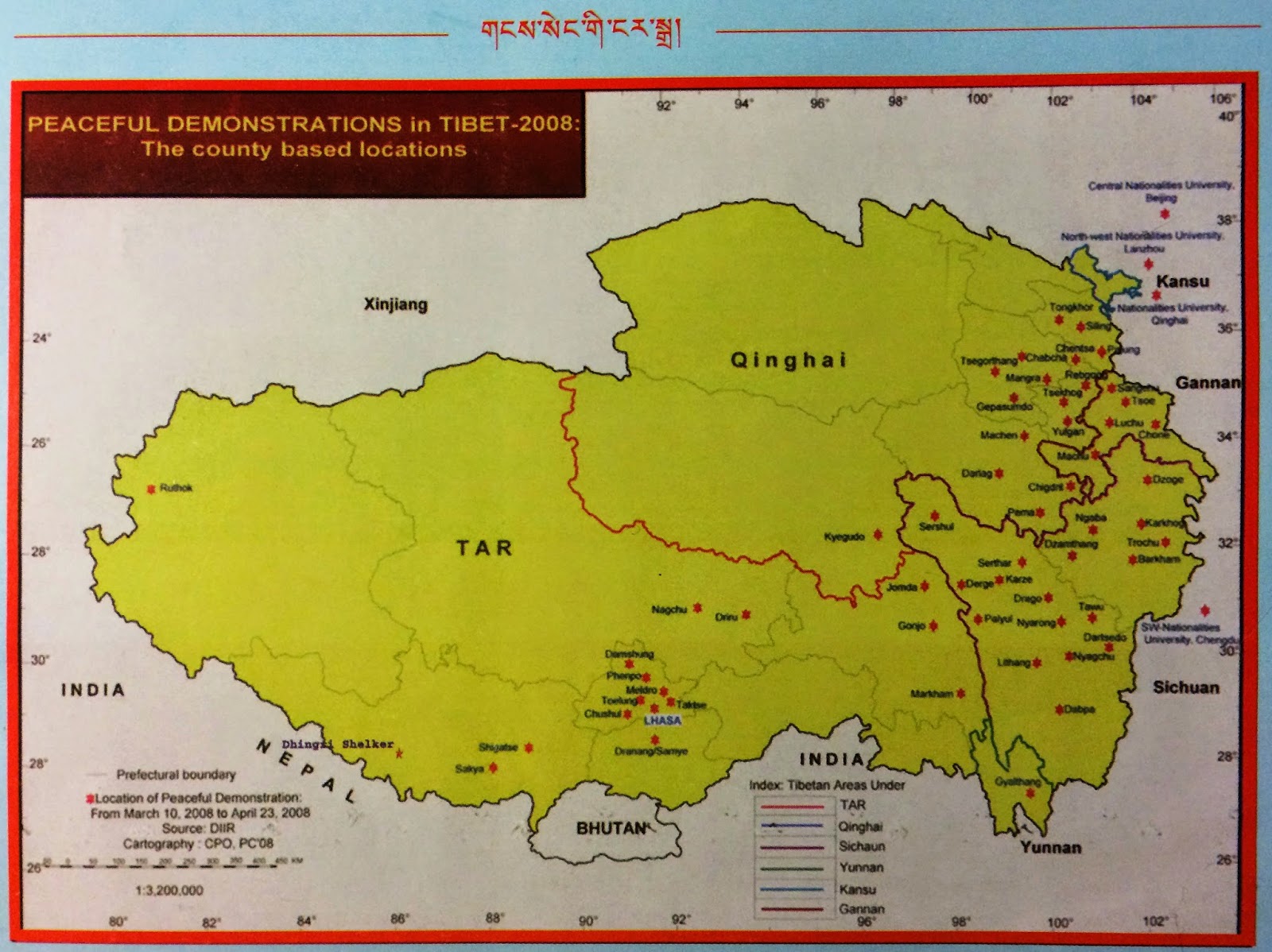 Map of the 2008 protests that spread across Tibet
Map of the 2008 protests that spread across Tibet
High Peaks Pure Earth has translated a blogpost by Woeser written in April 2014 for the Tibetan service of Radio Free Asia and published on her blog on April 18, 2014.
Woeser has been a prolific and consistent commentator on the ongoing self-immolations in Tibet and this is a good follow up to her last post “Self-Immolations Are A Kind of Political Resistance”.
The most recent self-immolation was by 22 year old student Lhamo Tashi and it was a fatal one. It took place on September 17, 2014 in Tsoe County, Gansu Province. However, recent news has emerged of a self-immolation that took place in Golog one day before Lhamo Tashi’s, by a 42 year old man called Kunchok who at the time of writing had survived and was being treated for his injuries.
“Why do Tibetans Self-Immolate?”
By Woeser
Countless people have asked me: why do Tibetans self-immolate? My answer is always, Tibetans use self-immolation as a way to resist because they are suffering from ever-increasing oppression, a kind of oppression that manifests itself through the following examples:
1. The political violence against traditional Tibetan Buddhism and religious beliefs and practices. In 1995, Beijing broke off relations with the Dalai Lama over the issue of the reincarnation of the 10th Panchen Lama. Subsequently, “work groups” were stationed in Lhasa’s main monasteries and “patriotic education” campaigns were launched, requesting all monks to openly declare their opposition to the Dalai Lama, otherwise they would be persecuted or even arrested. In 2008, the expulsion of all non-local monks studying in Lhasa’s three main monasteries led to the biggest and most far-reaching protests that spread across the whole of Tibet in March 2008. Afterwards, “patriotic education” was extended to all monasteries in the Tibetan region; it was stipulated that in all monasteries, temples and residences, the Chinese flag and portraits of the CCP leaders had to be hung up, which instigated a great deal of discontent among monks. In the case of ordinary believers, the government went from house to house, inspecting every single person and confiscating images of the Dalai Lama and even arresting individuals for watching videos of the Dalai Lama giving Buddhist teachings.
2. The destruction of the environment on the Tibetan plateau. The Chinese government has been destroying the plateau’s grasslands for years but is instead blaming local Tibetan nomads who have been living on these grasslands for thousands of years, forcing them to leave their horsebacks, livestock and grasslands, moving them into the outskirts of big cities. They have literally been pulled out of their sacred mountain and holy water – their home – hereby completely transforming their language, culinary habits and lifestyles that were related to countless spiritual and biological factors. They have been entirely deprived of their strength, respect and memory; Tibetans have no voice in this kind of “integration”; it is painful. Ironically, after the nomads had been moved, the grasslands did by no means recover; on the contrary, outsiders rushed in, equipped with construction plans, detonators and excavators, and built mining dykes and water ponds on the deserted grasslands and rivers, hereby utterly destroying them. They created a scenery of devastation and pollution, causing earthquakes, land- and mudslides and other frightening disasters.
3. The constant weakening of Tibetan language education. The reason for this should not be limited to the CCP’s assimilation efforts and the idea of cultural unity. For example, the Tibetan language education policy, “Mandarin first, Tibetan second”, in Qinghai Province has been considered a “key political endeavour” for the future. It shows that the main lesson that the local authorities learnt from the 2008 protests is that they regard Tibetan as a direct threat and now have the intention to systematically eliminate it to finally realise their aim of establishing “stability”.
4. The increase of migration into Tibet. Under the umbrella of attracting qualified personnel and investment, migrants have been enjoying all kinds of special benefits in Tibet with regards to taxation, land requisition, finance, household registration etc. Persons recruited from within the military or police force and sent to Tibet to “stabilise” it after 2008, represents one method of migration.
5. The pervasiveness of monitoring and control measures. The local government has put a great amount of effort into developing and spreading an Orwellian monitoring system in Tibet. The so-called “grid management” system, to use the words of the local authorities, aims at “establishing a dragnet to safeguard stability”. A western journalist visiting Tibet before 2008 wrote, “one can feel the fear of Tibetans with one’s hands”. Today, however, this fear has already saturated the air of Tibet, it is present everywhere at all times.

Furthermore, the special talks that the Chinese government carried out with the Dalai Lama between 2002 and 2008, were merely for international public relations in preparation for the Beijing Olympics. Tibetans inside Tibet entertained genuine hope and waited patiently. But in 2008, the Dalai Lama said in a speech commemorating the March 10th protests: “Since 2002, my representatives have met the government of the PPC six times to discuss particular issues… but it is very regretful that these talks did not lead to any substantial results, even worse, the cruel oppression of Tibetans inside Tibet has become worse over the past few years.”
The words of His Holiness served as a wake-up call for the Tibetans who had been waiting patiently up till then. During this time period, the 11th Panchen Lama was imprisoned, the 17th Karmapa escaped to India and the Dalai Lama, whom Tibetans worship so much, was demonised day after day. The first people to hear about the Dalai Lama’s speech were monks from Sera monastery in Lhasa, at once, some people expressed the need “to stand up”; they took to the streets, waving the Snow Lion flag and shouting slogans requesting freedom. These were the first voices, the beginning of the large-scale protests that swept across Tibet in 2008.
In the afternoon of the same day, several hundred monks of Drepung monastery came down from the mountain to protest and soon after, nuns and monks from all Lhasa monasteries gathered together, calling for actions; what followed was what the Chinese would later label the “March 14th Incident”.
April 2014





United we stand. Woeser we stand by you, please keep up your good work. We need millions of people like you Woeser. Best of luck.